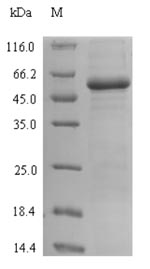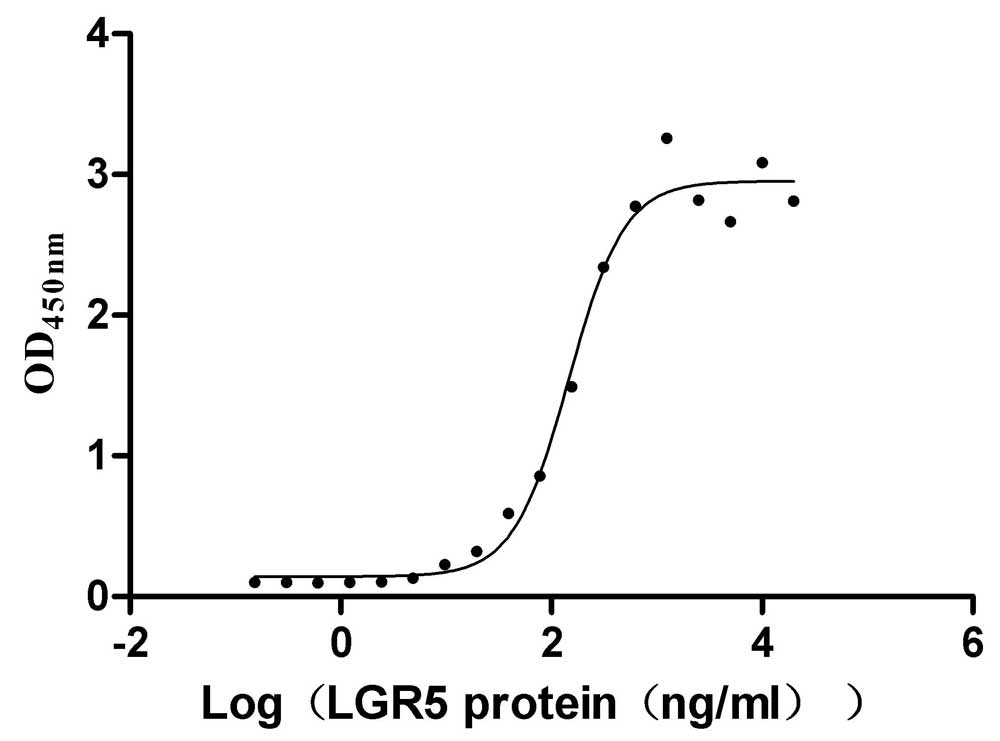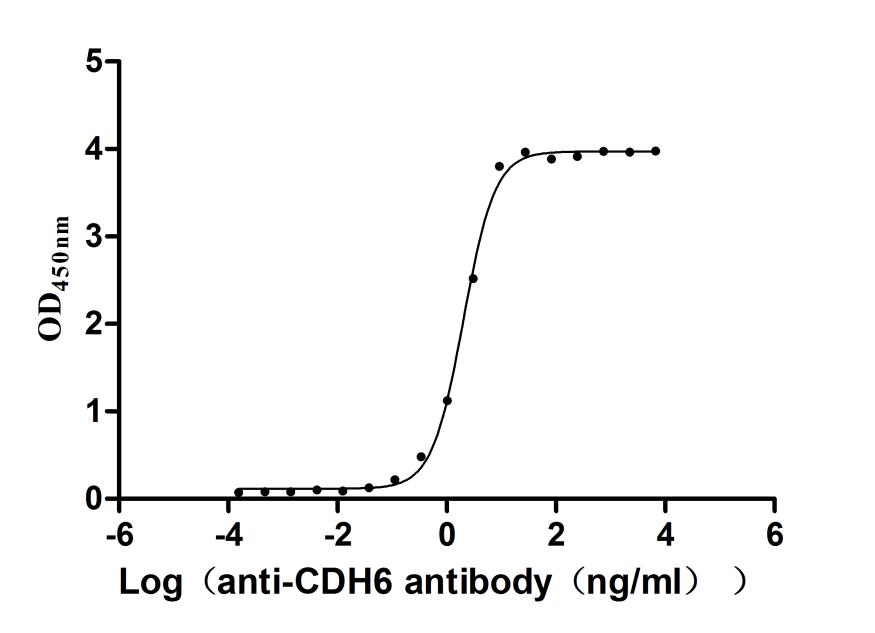Recombinant Escherichia coli Lactose operon repressor (lacI)
In Stock-
中文名称:大肠杆菌lacI重组蛋白
-
货号:CSB-EP365825ENV
-
规格:¥2328
-
图片:
-
其他:
产品详情
-
纯度:Greater than 90% as determined by SDS-PAGE.
-
基因名:lacI
-
Uniprot No.:
-
别名:lacI; b0345; JW0336; Lactose operon repressor
-
种属:Escherichia coli (strain K12)
-
蛋白长度:Full Length
-
来源:E.coli
-
分子量:54.6kDa
-
表达区域:1-360aa
-
氨基酸序列MKPVTLYDVAEYAGVSYQTVSRVVNQASHVSAKTREKVEAAMAELNYIPNRVAQQLAGKQSLLIGVATSSLALHAPSQIVAAIKSRADQLGASVVVSMVERSGVEACKAAVHNLLAQRVSGLIINYPLDDQDAIAVEAACTNVPALFLDVSDQTPINSIIFSHEDGTRLGVEHLVALGHQQIALLAGPLSSVSARLRLAGWHKYLTRNQIQPIAEREGDWSAMSGFQQTMQMLNEGIVPTAMLVANDQMALGAMRAITESGLRVGADISVVGYDDTEDSSCYIPPLTTIKQDFRLLGQTSVDRLLQLSQGQAVKGNQLLPVSLVKRKTTLAPNTQTASPRALADSLMQLARQVSRLESGQ
Note: The complete sequence including tag sequence, target protein sequence and linker sequence could be provided upon request. -
蛋白标签:N-terminal 6xHis-SUMO-tagged
-
产品提供形式:Liquid or Lyophilized powder
Note: We will preferentially ship the format that we have in stock, however, if you have any special requirement for the format, please remark your requirement when placing the order, we will prepare according to your demand. -
缓冲液:Tris-based buffer,50% glycerol
-
储存条件:Store at -20°C/-80°C upon receipt, aliquoting is necessary for mutiple use. Avoid repeated freeze-thaw cycles.
-
保质期:The shelf life is related to many factors, storage state, buffer ingredients, storage temperature and the stability of the protein itself.
Generally, the shelf life of liquid form is 6 months at -20°C/-80°C. The shelf life of lyophilized form is 12 months at -20°C/-80°C. -
货期:3-7 business days
-
注意事项:Repeated freezing and thawing is not recommended. Store working aliquots at 4°C for up to one week.
-
产品描述:
This Recombinant E.coli K12 lacI protein was made through genetic engineering. By putting the lacI gene into the genetic material of E.coli cell, the E.coli could be used as factories or producers to make the desired lacI protein for research uses. The expression region of this protein is at 1-360aa. N-terminal 6xHis-SUMO tag was used in the expression process. The purity is 90%+ determined by SDS-PAGE.
The lactose repressor protein (LacI) was among the very first genetic regulatory proteins discovered, and more than 1000 members of the bacterial LacI/GalR family are now identified. LacI has been the prototype for understanding how transcription is controlled using small metabolites to modulate protein association with specific DNA sites. This understanding has been greatly expanded by the study of other LacI/GalR homologues. A LacI, a bacterial TF, is often used to artificially recruit proteins onto eukaryotic genomes. As LacI binds tightly to its recognition site (LacO) in vitro with a Kd about 10 picomolar (pM), it is often assumed that LacI also has high affinity to LacO in vivo. It turns out that the GFP tagging location and the fusion protein stability have a large effect on LacI binding. The common function of the LacI/GalR proteins, which features allosteric regulation of DNA binding to modulate transcription. -
Datasheet & COA:Please contact us to get it.
相关产品
靶点详情
-
功能:Repressor of the lactose operon. Binds allolactose as an inducer.
-
基因功能参考文献:
- Effect of helix length on the stability of the Lac repressor antiparallel coiled coil. PMID: 25969365
- LacI autoregulation balances two opposing states, one that allows quicker response to smaller pulses of external lactose, and the other that minimizes production costs in the absence of lactose. PMID: 23658223
- Data indicate that in the absence of its inducer, LacI binds to primary operator lac O1 near the transcription start site of the lac operon, and represses its transcription. PMID: 22594825
- findings show the lac repressor slides 45 +/- 10 base pairs on chromosomal DNA and that sliding can be obstructed by other DNA-bound proteins near the operator; the repressor frequently slides over its natural lacO(1) operator several times before binding PMID: 22723426
- The role of lactose repressor residues asparagine-125 and aspartate-149 illustrate how readily the ligand binding and allosteric response function of a regulatory bacterial protein can be altered, generating diminished operator binding. PMID: 21928765
- Using the extensive LacI family of transcriptional factors, identified a set of specificity correlations--determined by two AAs of the TFs and two NTs in the binding sites- and that act as a relatively consistent recognition code. PMID: 21085639
- solution structure and dynamics of the complex of a dimeric lac repressor DNA binding domain with nonspecific DNA PMID: 15256668
- The Lac repressor artificially attached to the Escherichia coli cytoplasmic membrane is able to perfectly represses transcription initiated at the tac operator-promoter present on a plasmid and even in the chromosome. PMID: 15867195
- Linear DNA segments of short-to-medium chain length (50-180 bp) give rise to loops with the extended form of LacR and loops formed within negatively supercoiled plasmids induce the V-shaped structure. PMID: 16785444
- The mutational spectrum of the genomic lacI gene induced by low-energy nitrogen ion irradiation in wild type Escherichia coli strain W3110 were compared with the spontaneous and the vacuum controls. PMID: 17049362
- In single molecule experiments, both specific bending and non-specific compaction by integration host factor alter LacI-mediated looping of DNA PMID: 17543441
- The altered hydrogen bonding can account in part for the different structural conformations of the repressor, and is vital for the allosteric transition PMID: 17543986
- The structure of lactose repressor (LacI) protein confirms previously reported structures on the monomer level, however, the tetramer is much more densely packed. PMID: 19004002
- irradiation induces the change of the oligomerization state of LacI from tetramer to dimer. PMID: 19520056
显示更多
收起更多
-
数据库链接:
KEGG: ecj:JW0336
STRING: 316385.ECDH10B_1357
Most popular with customers
-
Recombinant Human R-spondin-1 (RSPO1), partial (Active)
Express system: Mammalian cell
Species: Homo sapiens (Human)
-
Recombinant Human C-X-C chemokine receptor type 4 (CXCR4)-VLPs (Active)
Express system: Mammalian cell
Species: Homo sapiens (Human)
-
Recombinant Human Complement component C1q receptor (CD93), partial (Active)
Express system: Mammalian cell
Species: Homo sapiens (Human)
-
Recombinant Human Claudin-3 (CLDN3)-VLPs (Active)
Express system: Mammalian cell
Species: Homo sapiens (Human)
-
Recombinant Human Carcinoembryonic antigen-related cell adhesion molecule 8(CEACAM8) (Active)
Express system: Mammalian cell
Species: Homo sapiens (Human)
-
Recombinant Mouse Cadherin-6(Cdh6),partial (Active)
Express system: Mammalian cell
Species: Mus musculus (Mouse)




-AC1.jpg)














